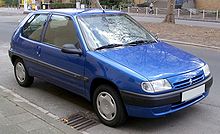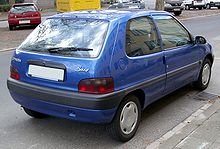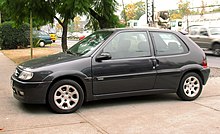| This article needs additional citations for verification. Please help improve this article by adding citations to reliable sources. Unsourced material may be challenged and removed. Find sources: "Citroën Saxo" – news · newspapers · books · scholar · JSTOR (March 2020) (Learn how and when to remove this message) |
| Citroën Saxo | |
|---|---|
 | |
| Overview | |
| Manufacturer | Citroën |
| Also called | Citroën Chanson (Japan, 1997–1999) |
| Production | 1996–2003 |
| Assembly | Aulnay-sous-Bois, France (PSA Aulnay-sous-Bois Plant) Mangualde, Portugal |
| Designer | Donato Coco |
| Body and chassis | |
| Class | Subcompact Car (B) |
| Body style | 3/5-door hatchback |
| Layout | Front-engine, front-wheel-drive |
| Related | Peugeot 106 Citroën AX |
| Powertrain | |
| Engine | |
| Transmission | 5-speed manual 3-speed automatic |
| Dimensions | |
| Wheelbase | 2,385 mm (93.9 in) |
| Length | 3,718 mm (146.4 in) 3,737 mm (147.1 in) (VTS) |
| Width | 1,595 mm (62.8 in) 1,620 mm (63.8 in) (VTS) |
| Height | 1,379 mm (54.3 in) |
| Curb weight | 805–935 kg (1,775–2,061 lb) |
| Chronology | |
| Predecessor | Citroën AX |
| Successor | Citroën C2 (three-door) Citroën C3 (five-door) |
The Citroën Saxo is a supermini produced by the French manufacturer Citroën from 1996 to 2003. It was sold in Japan as the Citroën Chanson, because Honda had registered the "Saxo" name. The Saxo was a development of the Citroën AX and Peugeot 106, which shared a platform and running gear (the major difference being interiors and body panels). It was discontinued in 2003, when it was replaced with the Citroën C2 and Citroën C3 which launched a year earlier. Both models were developed alongside the Peugeot 206.
Overview
Engines and performance
All engines were from the PSA TU engine series that powered the Peugeot 205 from 1988 and the Citroën AX, and had their roots before that with the OHC PSA X engine various other PSA cars used such as the Citroën Visa and the predecessors of the Peugeot 206 (Peugeot 104 and Peugeot 205). The range included five petrol engines and one diesel engine, all naturally aspirated.
Although the quoted power outputs are low in comparison to modern small hatchbacks, or even to other hatchbacks of the time, the kerb weight was generally very low, with even the range-topping VTS having a kerb weight of just 935 kg (2,061 lb), with other smaller engine models (except the diesel) being around 100 kg lighter than this.

This meant a high power to weight ratio resulting in decent acceleration and made the car suitable for city driving. Aside from the VTS which had 16 valves, all engines were the older SOHC units which meant relatively low city MPG figures. Even the popular 1.1i engine would struggle to achieve more than 35 to 40mpg in town when driven carefully.
The real world consumption between the smaller engines and the nippy 1.4i Westcoast/Furio variant was hardly noticeable, however the insurance premiums were. The early 1.0i was quite under powered, with the 1.1i being considered much better, since it was nearly 200cc larger and had roughly 30% more torque.
There were three sport models of the Saxo:
- The Westcoast, later replaced by the Furio which featured a 1.4I 8V 55 kW (75 hp) engine with a top speed of 175 km/h (109 mph), and a 0-62.5 mph (0–100 km/h) time of 11.2 seconds.
- The VTR MK1 (1997–1999) featured a fuel injected, 1.6-liter 8-valve 66 kW (90 hp) engine with a top speed of 187 km/h (116 mph) and a 0-62.5 mph (0–100 km/h) time of 10.0 seconds. The VTR MK2 (1999–2003) featured a 1.6I 8V 72 kW (98 hp) engine with a top speed of 193 km/h (120 mph) and a 0-62.5 mph (0–100 km/h) time of 9.4 seconds.
- The VTS 16V featured a 1.6I 88 kW (120 hp) engine with a top speed of 205 km/h (127 mph), and a 0 to 60 mph time of 7.8 seconds. The VTS MK1 (1997–1999) and MK2 (1999–2003) shared similar performance, although the MK2 was slightly slower due to it being marginally heavier.
These models included 247 mm (9.7 in) vented front brake discs, with the VTR and VTS also having rear brake discs (solid 247 mm (9.7 in) discs). Also, a different style of control arms and struts was used for the suspension. The VTS had a 22 mm (0.9 in) master brake cylinder, and the VTR and Westcoast/Furio had a 19 mm (0.7 in).
The VTS had a 19 mm (0.7 in) front anti roll bar and 22 mm (0.9 in) rear anti roll bar, while the VTR and Westcoast/Furio had a 19 mm (0.7 in) front and 21 mm (0.8 in) or sometimes 19 mm (0.7 in) rear antiroll bar. In addition, all the sports models featured a unique bodykit to the other models, commonly known as the "VT" bodykit.
In 1997, the Saxo's three speed automatic gearbox was combined with the 1.6i 8V 66 kW (90 hp) engine which was available on the Saxo SX and VSX. Then, in the end of 1997, the 1.6i automatic was replaced with a 1.4i 55 kW (75 hp) engine. The 1.6i was more powerful with a top speed of 176 km/h (109MPH) compared with the 1.4's top speed of 103 mph (166 km/h).


Citroën carried on using the 1.4i engine on the facelift Saxo Automatic in 1999. Due to the C3 having a 1.4i automatic gearbox, the Saxo Automatic came to an end in March 2002, whilst the manual models were still sold right up to the end of 2003.
- 1.0 L (954 cc) TU9 I4, 37 kW (50 hp) and 73 N⋅m (54 lb⋅ft)
- 1.1 L (1124 cc) TU1 I4, 44 kW (60 hp) and 89 N⋅m (66 lb⋅ft)
- 1.4 L (1360 cc) TU3 I4, 55 kW (75 hp) and 121 N⋅m (89 lb⋅ft)
- 1.5 L (1527 cc) TUD5 diesel I4, 43 kW (58 hp) and 117 N⋅m (86 lb⋅ft)
- 1.6 L (1587 cc) TU5 I4, 66 kW (90 hp) and 135 N⋅m (100 lb⋅ft)
- 1.6 L (1587 cc) TU5 I4, 72 kW (98 hp) and 135 N⋅m (100 lb⋅ft) (later VTR models)
- 1.6 L (1587 cc) TU5 I4, 88 kW (120 hp) and 145 N⋅m (107 lb⋅ft)
Interior and equipment

The equipment list was generally sparse, with budget models having drivers airbag, seat belt pre tensioners, cassette player, heated rear screen and tinted windows, and early Mark Ones with keypad immobilisers and a clock in place of a tachometer and three stud wheels, much like the AX. Further up the list sunroofs, PAS, Electric windows, ultrasonic alarm, passenger airbag, CD player, tachometer, front fog lights, bodykits, colour coded mirror caps and alloy wheels were added, to name a few.
Although MK2 Saxos were generally better equipped than their older counterparts, the interiors were still dated in comparison to other small hatchbacks of the time, such as the Vauxhall Corsa, with many of the center console controls originating from the older model of the Citroën AX.
The 1.6L VTR and VTS Saxos were the best equipped, with both gaining rear disc brakes as opposed to drum brakes, and ABS as standard for the VTS and an optional extra on all other 1.6-liter models.
Few special models were released throughout the Saxo's life, most notably the "Open Scandal", a Saxo with a full-length sliding canvas roof. Other special editions added certain extras to the lower end model, such as sunroofs or PAS. Notable models are the Westcoast up to 1999 and the Furio to 2003, as they incorporated the standard Saxo bodykit found on the VTR and VTS with a more insurance friendly 1.4-liter engine. The Westcoast is not to be confused with the Eastcoast, which was only available in the 1.0L and later 1.1L engines. The Eastcoast also did not incorporate the "VT" bodykit.
Air conditioning was never an option on right hand drive Saxos because the blower motor was mounted in the bulk head on the driver's side. As a result, there was insufficient space available to accommodate the evaporator, except by first ducting the air flow to the passenger's side and then at the expense of the glove box.
Although an after market kit was available that did exactly this, the resultant pressure loss made the system noisy and ineffective. The blower motor could also not be easily relocated, since the windscreen wiper motor was mounted in the passenger's side space.

 Citroën Saxo (facelift)
Citroën Saxo (facelift)
In September 1999, the Saxo received a facelift, commonly branded as a Mark II, with the major differences being more modern styled headlights, bonnet and grille to replace the square style on the MK1 and multipoint injection replacing the single point on the 1.1-liter engines. In September 2000, it was a Euro NCAP sufferer of poor results, along with its twin, the 106.
Power steering became standard on all but the very basic models. More subtle changes were alterations to the rear lights (the indicator sections are more "white") and the engine control unit moved from a single plug to three plugs. The old three-stud wheel layout, as used on the Citroën AX, was also dropped. There was also a minor facelift, during the first phase of the car's production, in line with the then current releases by Citroën, moving towards a rounder look.
While the exterior was markedly altered, little changed inside the vehicle. The dashboard and glovebox arrangement remained the same with the possibility of installing a passenger-side airbag in some high range models.
By 2003, some buyers were more attracted to the spacious, and practical five-door C3. However, the 1.6 VTR and VTS models remained popular. The Saxo finally finished production in September 2003, when the three-door C2 was launched. Its twin, the Peugeot 106, also ceased production at this time. By the end of the Saxo's production life, its design was seven years old.
Drag coefficient
The Saxo has a drag coefficient of Cd=0.340. In addition its frontal area is 1.83 m, giving it a CdA ft² of 6.68.
See also
References
- Ciferri, Luca. "Who designed current production cars?". Automotive News Europe. Archived from the original on 3 May 2022.
- Marsh, Julian. "Citroën Chanson - Japanese market Saxo". Citroënët. Archived from the original on 26 March 2017.
- ^ "Citroën Saxo 1.1i X technical specifications - Carfolio.com car specifications pages". Carfolio.com. Retrieved 7 August 2011.
| Citroën | ||||||||
|---|---|---|---|---|---|---|---|---|
| A marque of Stellantis | ||||||||
| Current models |
|  | ||||||
| Historic models | ||||||||
| Concepts, prototypes |
| |||||||
| Motorsport |
| |||||||
| Regional operations |
| |||||||